Below are photos from the recent trip to North Carolina. The first photograph is of a Confederate light saber recovered from the Monroe’s Crossroads battlefield that is owned by a fellow named Al Potts. The wrist guard is bent, but Mr. Potts does not know whether it is battle damage. The blade is pretty chewed up, but I couldn’t tell if it was from battle or from being exposed to the elements. The next batch of photos are from the Guilford Court House National Military Park. There are 32 monuments on the Guilford Court House battlefield and we photographed most of them. The last batch of pictures are from the Jeb Stuart birthplace.
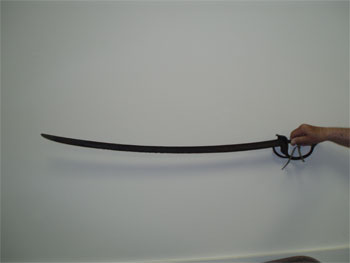
This is Al Pott’s Ames Confederate saber, found on the Monroe’s Crossroads battlefield before it was part of Fort Bragg. It’s oxidized black. The blade, as you can see, is in rough shape. The wrist guard is damaged.
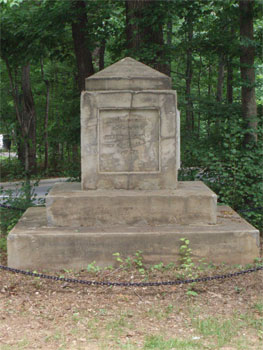
This is the grave of Brig. Gen. Jethro Sumner, who commanded the 3rd North Carolina Infantry from 1776-1780. At the time of the Battle of Guilford Court House, he was a colonel. His unit did not fight in the battle. It was on detached duty in Hillsborough. However, Sumner was buried on the battlefield in 1891.
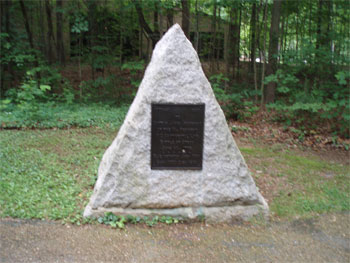
This is a monument to Capt. James Morehead. His descendant was one of the founders of the company that erected these monuments before the National Park Service acquired the land that makes up the park. The monument is shaped like a pup tent in honor of Morehead’s military service.

There are two monuments to women on the battlefield. Karrenhappuch Norman Turner was an ancestor of the Morehead family. According to family legend, she supposedly rode from Maryland to tend a seriously wounded son after the battle. The cup and towel in the statue’s hands were the simple tools of her care.
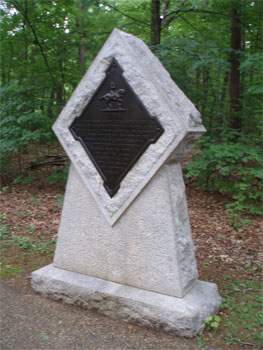
This is the Bugler Gillies Monument. James Gillies was a young bugler in “Lighthorse Harry” Lee’s Legion, killed by Tarleton’s British cavalry in February 1781 near present-day Oak Ridge.
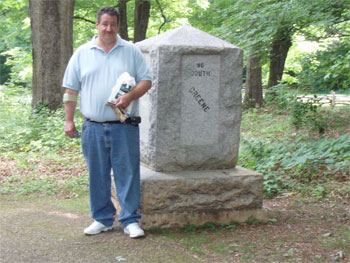
Me standing by the “No North, No South” monument, which was dedicated in 1903. It has Nathanael Greene’s name on one side with the word “South” and George Washington’s name on the other with the word “north”. The people who saw the split of the nation due to the Civil War in 1861 erected this monument to renewed nationalism. Greene, a New Englander, led southern troops while Washington, a southerner, led northern troops.
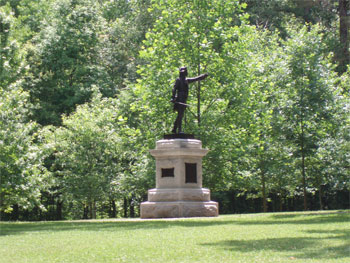
This is the Joseph Winston monument. It’s located on the end of the second American battle line. Major Joseph Winston commanded the Surry County, North Carolina militia in the battle.
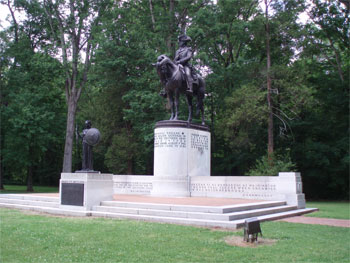
This handsome equestrian monument was dedicated in 1915. It depicts the American commander, Maj. Gen. Nathanael Greene. Greene was perhaps the finest of all of George Washington’s subordinates. The battle plan–a defense in depth–was designed by Greene, who earned the respect of his British counterpart, Charles Cornwallis.

This monument commemorates the three Tarheels who signed the Declaration of Independence and marks the graves of two of them. William Hooper, Joseph Hewes, and John Penn all signed the Declaration of Independence in 1776. Hooper’s and Penn’s remains were re-bruied in the park in 1897, while Hewes’ remains lie in Christ Churchyard in Philadelphia. The monument and remains were moved to the present location in 1976. The bronze statue is of Hooper, the “Orator of the Congress”.
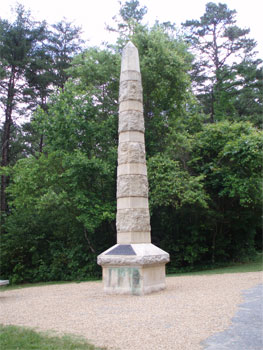
The American cavalry was honored by this monument. Two bronze tablets honor the “Virginia Giant” Peter Francisco, who killed eleven men with his broadsword during the Battle of Guilford Court House, Lt. Col. William Washington (cousin of George Washington, and commander of the American cavalry), and the Marquis de Britigny, a French volunteer.
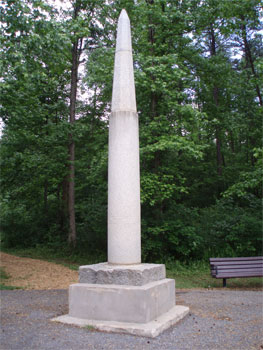
This is a monument to the Continental Regulars of Greene’s army. It was also supposed to mark the third American line of battle, but subsequent research has shown that it is misplaced by about a quarter of a mile. The real third line position was at the original county court house site, which sat atop a prominent ridge. Greene chose this position wisely, and it was stoutly defended by his Continentals.
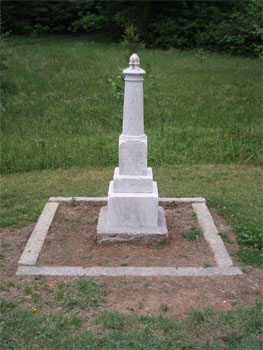
This is the James Stuart monument, which is the only monument on the battlefield to a British soldier. Lt. Colonel James Stewart (as spelled on British military documents) of the Brigade of Guards was killed in the fighting on the third line. The monument marks the spot where a sword was found in 1866. The sword was engraved with the coat of arms of the Bllantyre family, connecting it to Stewart.

I took this beautiful panoramic view standing at the monument to the Continentals. The Stuart monument is partway down the ridge. You can see the Cavalry Monument in the distance on the other side of the valley. As stated above, the men who marked the field originally believed that this was the position of the American third line, but it wasn’t. I include this photo for a couple of reasons. First, you can see how beautiful this park is. Second, you can get a sense of the rolling terrain and very dense woods that played a major role in the development of this battle.
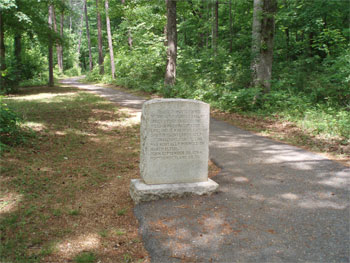
This was the last monument placed on the Guilford Court House battlefield in 1932. Capt. Griffin Murdock Fauntleroy of Northumberland County, Virginia was one of the most experienced soldiers in Nathanael Greene’s army. After serving in the 7th Virginia Infantry, he resigned his commission and instead accepted one as a captain in the First Continental Light Dragoons. He was mortally wounded and left on the battlefield at Guilford Court House.
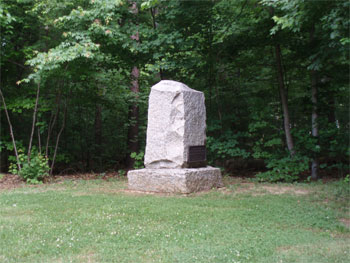
This is a monument to Nathaniel Macon, an officer in Greene’s army who left just before the battle to fill an elected seat in the North Carolina Assembly. He eventually became the Speaker of the United States House of Representatives.
That’s it for the Guilford Court House photos. The next batch come from the Jeb Stuart birthplace.
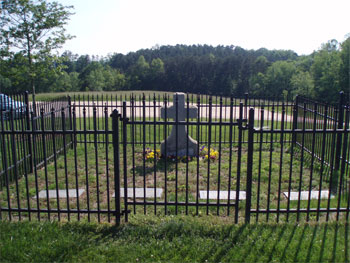
This fence and the cross are the original site of the graves of Jeb Stuart’s parents. The bodies were later disinterred and moved. However, they were an important part of the family farm, and their location remains marked by these cenotaphs today.
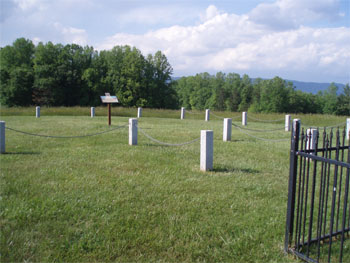
The family home burned in the 1840’s. Archaeologists have located the foundation. The granite markers show the perimeter of the house. Jeb Stuart was born in the house.
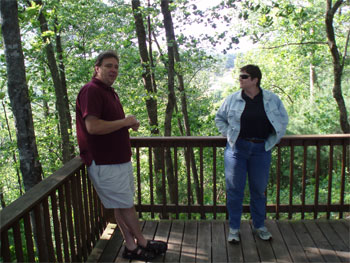
The Jeb Stuart Birthplace sits on a high ridge, overlooking the mighty Ararat River and the 1500 acres owned by Archibald Stuart. Jeb Stuart’s maternal great-grandfather, William Letcher, was a patriot. British Tories killed him during the Revolutionary War, and he was buried in the valley overlooking the mighty Ararat. It’s in the valley below. With Susan in this photo is Thomas D. Perry, whose efforts are responsible for saving and preserving the Jeb Stuart Birthplace.
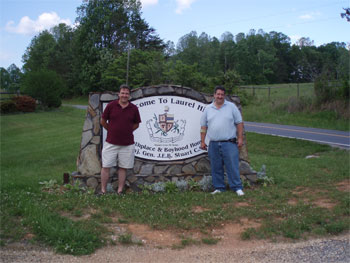
Tom and me by the big sign that marks the entry to the Birthplace property.
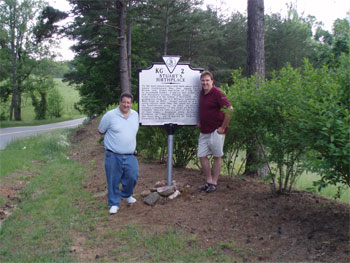
Tom and me by the Virginia state historical marker just outside the Birthplace property. Tom says that the prior version of this sign is what got him interested in Jeb Stuart and in the Civil War.
That’s it for the photos from this trip. I hope you’ve enjoyed them.
Scridb filterComments
Comments are closed.
Notice: Undefined index: id in /home/netscrib/public_html/civilwarcavalry/wp-content/themes/wittenberg/footer.php on line 8
Notice: Undefined index: id in /home/netscrib/public_html/civilwarcavalry/wp-content/themes/wittenberg/footer.php on line 8
Notice: Undefined index: std in /home/netscrib/public_html/civilwarcavalry/wp-content/themes/wittenberg/footer.php on line 8
Notice: Undefined index: id in /home/netscrib/public_html/civilwarcavalry/wp-content/themes/wittenberg/footer.php on line 8
Notice: Undefined index: id in /home/netscrib/public_html/civilwarcavalry/wp-content/themes/wittenberg/footer.php on line 8
Notice: Undefined index: std in /home/netscrib/public_html/civilwarcavalry/wp-content/themes/wittenberg/footer.php on line 8
Notice: Undefined index: id in /home/netscrib/public_html/civilwarcavalry/wp-content/themes/wittenberg/footer.php on line 8
Notice: Undefined index: id in /home/netscrib/public_html/civilwarcavalry/wp-content/themes/wittenberg/footer.php on line 8
Notice: Undefined index: std in /home/netscrib/public_html/civilwarcavalry/wp-content/themes/wittenberg/footer.php on line 8
Notice: Undefined index: id in /home/netscrib/public_html/civilwarcavalry/wp-content/themes/wittenberg/footer.php on line 8
Notice: Undefined index: id in /home/netscrib/public_html/civilwarcavalry/wp-content/themes/wittenberg/footer.php on line 8
Notice: Undefined index: std in /home/netscrib/public_html/civilwarcavalry/wp-content/themes/wittenberg/footer.php on line 8
Notice: Undefined index: id in /home/netscrib/public_html/civilwarcavalry/wp-content/themes/wittenberg/footer.php on line 8
Notice: Undefined index: id in /home/netscrib/public_html/civilwarcavalry/wp-content/themes/wittenberg/footer.php on line 8
Notice: Undefined index: std in /home/netscrib/public_html/civilwarcavalry/wp-content/themes/wittenberg/footer.php on line 8
Notice: Undefined index: id in /home/netscrib/public_html/civilwarcavalry/wp-content/themes/wittenberg/footer.php on line 8
Notice: Undefined index: id in /home/netscrib/public_html/civilwarcavalry/wp-content/themes/wittenberg/footer.php on line 8
Notice: Undefined index: std in /home/netscrib/public_html/civilwarcavalry/wp-content/themes/wittenberg/footer.php on line 8
Notice: Undefined index: id in /home/netscrib/public_html/civilwarcavalry/wp-content/themes/wittenberg/footer.php on line 8
Notice: Undefined index: id in /home/netscrib/public_html/civilwarcavalry/wp-content/themes/wittenberg/footer.php on line 8
Notice: Undefined index: std in /home/netscrib/public_html/civilwarcavalry/wp-content/themes/wittenberg/footer.php on line 8
Notice: Undefined index: id in /home/netscrib/public_html/civilwarcavalry/wp-content/themes/wittenberg/footer.php on line 8
Notice: Undefined index: id in /home/netscrib/public_html/civilwarcavalry/wp-content/themes/wittenberg/footer.php on line 8
Notice: Undefined index: std in /home/netscrib/public_html/civilwarcavalry/wp-content/themes/wittenberg/footer.php on line 8
Notice: Undefined index: id in /home/netscrib/public_html/civilwarcavalry/wp-content/themes/wittenberg/footer.php on line 8
Notice: Undefined index: id in /home/netscrib/public_html/civilwarcavalry/wp-content/themes/wittenberg/footer.php on line 8
Notice: Undefined index: std in /home/netscrib/public_html/civilwarcavalry/wp-content/themes/wittenberg/footer.php on line 8
Notice: Undefined index: id in /home/netscrib/public_html/civilwarcavalry/wp-content/themes/wittenberg/footer.php on line 8
Notice: Undefined index: id in /home/netscrib/public_html/civilwarcavalry/wp-content/themes/wittenberg/footer.php on line 8
Notice: Undefined index: std in /home/netscrib/public_html/civilwarcavalry/wp-content/themes/wittenberg/footer.php on line 8
Notice: Undefined index: id in /home/netscrib/public_html/civilwarcavalry/wp-content/themes/wittenberg/footer.php on line 8
Notice: Undefined index: id in /home/netscrib/public_html/civilwarcavalry/wp-content/themes/wittenberg/footer.php on line 8
Notice: Undefined index: std in /home/netscrib/public_html/civilwarcavalry/wp-content/themes/wittenberg/footer.php on line 8
Notice: Undefined index: id in /home/netscrib/public_html/civilwarcavalry/wp-content/themes/wittenberg/footer.php on line 8
Notice: Undefined index: id in /home/netscrib/public_html/civilwarcavalry/wp-content/themes/wittenberg/footer.php on line 8
Notice: Undefined index: std in /home/netscrib/public_html/civilwarcavalry/wp-content/themes/wittenberg/footer.php on line 8
Notice: Undefined index: id in /home/netscrib/public_html/civilwarcavalry/wp-content/themes/wittenberg/footer.php on line 8
Notice: Undefined index: id in /home/netscrib/public_html/civilwarcavalry/wp-content/themes/wittenberg/footer.php on line 8
Notice: Undefined index: std in /home/netscrib/public_html/civilwarcavalry/wp-content/themes/wittenberg/footer.php on line 8
Notice: Undefined index: id in /home/netscrib/public_html/civilwarcavalry/wp-content/themes/wittenberg/footer.php on line 8
Notice: Undefined index: id in /home/netscrib/public_html/civilwarcavalry/wp-content/themes/wittenberg/footer.php on line 8
Notice: Undefined index: std in /home/netscrib/public_html/civilwarcavalry/wp-content/themes/wittenberg/footer.php on line 8
Notice: Undefined index: id in /home/netscrib/public_html/civilwarcavalry/wp-content/themes/wittenberg/footer.php on line 8
Notice: Undefined index: id in /home/netscrib/public_html/civilwarcavalry/wp-content/themes/wittenberg/footer.php on line 8
Notice: Undefined index: std in /home/netscrib/public_html/civilwarcavalry/wp-content/themes/wittenberg/footer.php on line 8
Notice: Undefined index: id in /home/netscrib/public_html/civilwarcavalry/wp-content/themes/wittenberg/footer.php on line 8
Notice: Undefined index: id in /home/netscrib/public_html/civilwarcavalry/wp-content/themes/wittenberg/footer.php on line 8
Notice: Undefined index: std in /home/netscrib/public_html/civilwarcavalry/wp-content/themes/wittenberg/footer.php on line 8
Notice: Undefined index: id in /home/netscrib/public_html/civilwarcavalry/wp-content/themes/wittenberg/footer.php on line 8
Notice: Undefined index: id in /home/netscrib/public_html/civilwarcavalry/wp-content/themes/wittenberg/footer.php on line 8
Notice: Undefined index: std in /home/netscrib/public_html/civilwarcavalry/wp-content/themes/wittenberg/footer.php on line 8
Notice: Undefined index: id in /home/netscrib/public_html/civilwarcavalry/wp-content/themes/wittenberg/footer.php on line 8
Notice: Undefined index: id in /home/netscrib/public_html/civilwarcavalry/wp-content/themes/wittenberg/footer.php on line 8
Notice: Undefined index: std in /home/netscrib/public_html/civilwarcavalry/wp-content/themes/wittenberg/footer.php on line 8
Notice: Undefined index: id in /home/netscrib/public_html/civilwarcavalry/wp-content/themes/wittenberg/footer.php on line 8
Notice: Undefined index: id in /home/netscrib/public_html/civilwarcavalry/wp-content/themes/wittenberg/footer.php on line 8
Notice: Undefined index: std in /home/netscrib/public_html/civilwarcavalry/wp-content/themes/wittenberg/footer.php on line 8
Notice: Undefined index: id in /home/netscrib/public_html/civilwarcavalry/wp-content/themes/wittenberg/footer.php on line 8
Notice: Undefined index: id in /home/netscrib/public_html/civilwarcavalry/wp-content/themes/wittenberg/footer.php on line 8
Notice: Undefined index: std in /home/netscrib/public_html/civilwarcavalry/wp-content/themes/wittenberg/footer.php on line 8
Notice: Undefined index: id in /home/netscrib/public_html/civilwarcavalry/wp-content/themes/wittenberg/footer.php on line 8
Notice: Undefined index: id in /home/netscrib/public_html/civilwarcavalry/wp-content/themes/wittenberg/footer.php on line 8
Notice: Undefined index: std in /home/netscrib/public_html/civilwarcavalry/wp-content/themes/wittenberg/footer.php on line 8







 Back to top
Back to top Blogs I like
Blogs I like 
Eric,
Thanks for sharing the photos. Have yet to be in that neck of the woods, and can see both places would be most worthy of a visit. Am guessing you had both places to yourselves while you were there.
Hope all is well.
Steve
Steve,
Surprisingly enough, no. Guilford has lots of neat paths through the dense woods, and there were lots of folks out jogging, walking, exercising dogs, taking babies for walks, etc. It’s a beautiful setting in the midst of a very nice upper middle class suburb, and it’s a very popular site with the locals. I can tell you, though, that there weren’t many folks out there actually touring the battlefield as a battlefield.
When we got to Laurel Hill, there was another vehicle there, which turned out to be one of Tom’s childhood friends, romancing his lady fair. That really surprised me. 🙂
Glad you enjoyed the photos. It was a lot packed into one day, but it was a lot of fun.
Eric
Eric,
LOL. 🙂 What is it with hills of the Civil War History? Benner’s Hill and now Laurel Hill? 🙂 Loved the photos, especially the one that showed the terrain at Guilford Court House Battlefield.
Good stuff. 🙂
Steve
Re photo of Confederate light sabre: I’ve seen all the Star Wars movies and can assure you that light sabres don’t look like that. You’ve been fooled.
Obi Wan Morgan
Obi Wan,
Point taken. 🙂
Luke
Fantastic photos, Eric. I haven’t been there yet either, but I certainly want to go. Beautiful park, and wonderfully monumented.
J.D.
I’m glad you appear to have enjoyed your trip to Greensboro. I used to live across the street from Guilford Courthouse (now i live closer to downtown) and agree that it is a very popular place with the locals. There is a lot of history to be found in the park.
If you find yourself in the area again, stop by the Greensboro Historical Museum downtown. Admission is free and they have several interesting permanent and rotating exhibits. One of their most interesting permanent exhibits deals with Civil War history, including an extensive collection of Confederate long arms.
Greg,
We did enjoy ourselves. It seems like a great town.
Eric